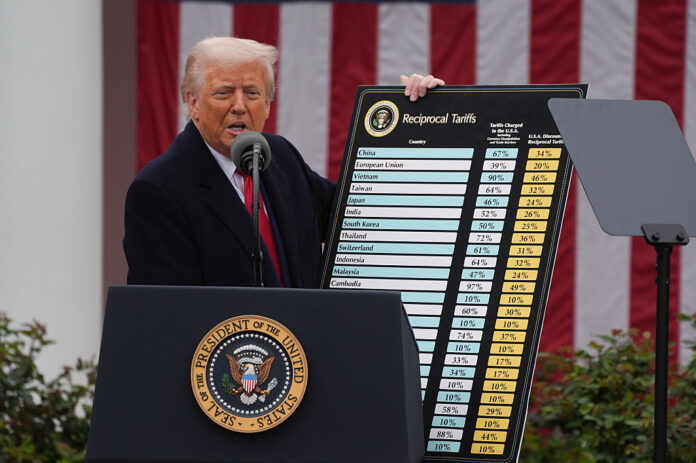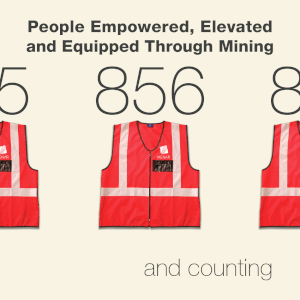By Mirna Fahmy
In a move that sent shockwaves through the global economy, the 47th President Donald Trump of the United States (U.S.) announced sweeping tariffs on April 2, 2025 — a date he proclaimed “Liberation Day.” The decision marks one of the most significant disruptions to the post-World War II global trade system, unsettling markets and prompting swift retaliation from key trading partners.
Starting April 5, a baseline 10% tariff will apply to all U.S. imports. In addition, 90 countries will face reciprocal tariffs — ranging from 11% to 50% — taking effect on April 9. These rates are calibrated to reflect what the administration describes as “unfair” trade barriers placed on American goods.
China will bear the steepest penalty, facing a cumulative tariff of 54% — including a newly imposed 34% duty — which has climbed to 104% following its retaliatory measures. Other notable figures include 20% for the European Union, 46% for Vietnam, and 49% for Cambodia.
He also launched a new trade war with Canada and Mexico by imposing a 25% tariff on most Canadian and Mexican goods, though he later granted indefinite exemptions for goods compliant with the United States–Mexico–Canada Agreement (UMSCA).
Cuba, Belarus, North Korea, and Russia were not subjected to new tariffs. Cuba and North Korea are under existing U.S. sanctions, while Belarus and Russia have high tariffs already in place. Russia’s exemption is also due to limited trade with the U.S. due to existing sanctions.
Vatican City, Palau, Seychelles, and Somalia were also exempted from the tariffs, likely due to their limited trade with the U.S. or special diplomatic considerations.
On social media, Trump declared, “The U.S. has massive financial deficits with China, the EU, and many others. The only way to fix this is with TARIFFS, which are now bringing tens of billions of dollars into the U.S.A.” He described tariffs as “a beautiful thing” and criticized the Biden administration for allowing trade surpluses with other nations to grow. “We are going to reverse it, and reverse it QUICKLY,” he vowed.
The Strategy Behind the Tariffs
Trump’s central goal is to reduce longstanding U.S. trade deficits, which he argues have eroded American manufacturing and compromised national security. By raising the cost of imported goods, the administration hopes to steer consumers toward American-made alternatives, reshoring production and strengthening domestic supply chains.
The Associated Press (AP) stated that the U.S. households could see annual costs rise by $3,800 due to higher prices for clothing (up 17%), electronics, and automobiles.
To implement the policy, Trump invoked the International Emergency Economic Powers Act (IEEPA), citing trade imbalances, currency manipulation, and high foreign VATs as threats to national economic security.
The administration’s “reciprocal tariff” model aims to mirror the rates other nations impose on U.S. goods. Press Secretary Karoline Leavitt echoed this principle in a press briefing, saying, “It’s the golden rule we all learned in school: Treat others the way you want to be treated.”
Countries like China, the EU, Vietnam, and India were singled out for what the administration views as excessive tariffs or trade barriers against American exports.
The Global Response: Retaliation and Repercussions
Predictably, global backlash was swift. China condemned the move as a violation of the World Trade Organization (WTO) rules, calling it “unilateral bullying.” Beijing responded with a 84% tariff on U.S. imports effective April 10 and imposed export controls on seven categories of rare-earth minerals vital to U.S. industries. Eleven American firms were blacklisted, and anti-dumping investigations were launched.
In a further escalation, Trump threatened on April 7 to impose an additional 50% tariff on China unless it reverses its retaliatory measures immediately — and said all discussions with Beijing would be canceled.
EU President Ursula von der Leyen outlined plans for countermeasures targeting U.S. steel and other sectors. Spain and Poland criticized the U.S. action, with Spanish Prime Minister Pedro Sánchez promising proportional retaliation.
Japan, where Trump’s tariffs now stand at 24%, also condemned the move. Prime Minister Shigeru Ishiba — who once dismissed similar concerns as “theoretical” — now calls the tariffs “extremely regrettable.” Japan is weighing “all available options” for a response. Trump, meanwhile, has expressed frustration that Japanese cars dominate the U.S. market, while American cars struggle to appeal to Japanese consumers. In a later post on April 7,
Australia’s Prime Minister Anthony Albanese called the move “totally unwarranted” and “not the act of a friend.” Brazil passed a bill authorizing reciprocal measures and is considering a WTO appeal.
Some countries, especially those with lower tariff levels under Trump’s rules, are opting for diplomacy. Italy’s Prime Minister Giorgia Meloni urged negotiation, advocating for complete tariff removal instead of escalation. Israel, which had already dropped its own tariffs on U.S. goods, is hoping for a reduction of the 17% tariff currently levied by Washington.
Cambodia offered to slash its tariffs on U.S. goods from 35% to 5% in exchange for a renegotiation of the 49% rate it now faces. Vietnam proposed eliminating all tariffs on American goods in return for a 45-day pause on the new levies.
Taiwan declined to retaliate, expressing hope for “zero tariffs” through negotiation. British politician Nigel Farage, meanwhile, pointed out that the UK’s 10% tariff — while painful — was still better than the EU’s 20%, blaming slow Brexit execution for the lack of a U.S.-UK free trade deal.
Economic Fallout: Global Markets Rattled
The tariff announcement triggered a global selloff. The S&P 500 lost a staggering $5 trillion in value over two days — the steepest drop since the COVID-19 pandemic. The Dow and other major indices followed suit with 2,200 points low in a single trading session. European markets such as the FTSE 100 and DAX slumped, while Japan’s Nikkei 225 suffered significant losses.
Hong Kong’s Hang Seng Index plunged over 13%, marking its steepest drop since the financial crisis of 2008. European indices also suffered significant losses, with exporters particularly hard-hit due to tariffs on goods sold to the U.S.
The unpredictability surrounding tariff rates and potential retaliatory measures created an environment of heightened risk for investors. Analysts warned that higher manufacturing costs, disrupted supply chains, and diminished business confidence would slow global economic growth.
Seeking refuge in a safer asset, gold prices surged past $3,000 per ounce as investors used them as alternatives.
On the other side, crude oil prices tumbled below $60 (fell by 6-8%) per barrel for the first time since 2021, driven by a combination of economic uncertainty and increased production by OPEC. Analysts also cited weakened demand due to rising fears of recession. Despite not directly targeting oil, Trump’s tariffs have amplified global anxiety, contributing to falling prices across key commodities.
Trump seized on the economic data to pressure the Federal Reserve, stating that with oil, food prices, and interest rates down, there should be “NO inflation” — and that the Fed should move quickly to cut rates.
Will Global Trade be re-shaped?
In 2024, China and Canada ranked among the top three U.S. trading partners, with China importing approximately $143 billion worth of American goods, according to Statista. However, during Trump’s previous term, escalating trade tensions and tit-for-tat tariffs pushed China to diversify its import sources — reducing its reliance on U.S. goods and turning instead to suppliers like Brazil and Argentina, particularly for key agricultural products such as soybeans.
Paradoxically, the new wave of U.S. tariffs may offer China a strategic opening. While Washington aims to isolate Beijing economically, the disruptions have made trade with China more attractive to nations struggling to access the U.S. market. Countries once critical of China’s trade practices — including issues of overcapacity and state subsidies — are increasingly viewing Beijing as a vital economic partner.
As a result, China is deepening its commercial ties with emerging economies such as Brazil, Türkiye, and Southeast Asian nations, while simultaneously reinforcing connections with traditional rivals like Canada and the European Union. This expanding network of trade partners, bolstered by the Belt and Road Initiative (BRI), positions China to extend its influence across Asia, Africa, and Europe — and to further decouple from U.S. economic dependence.
One area of potential trade diversion lies in the transatlantic energy relationship. Trump has urged the EU to continue purchasing U.S. energy, but a growing number of European leaders are wary of dependency. Since the outbreak of the Russia-Ukraine war, the U.S. has largely replaced cheaper Russian gas with liquefied natural gas (LNG) exports to Europe — often at double the price — a shift that has benefited American energy firms but strained European economies.
In response to shifting trade dynamics, the EU is actively seeking alternatives. On April 3–4, 2025, EU and Central Asian leaders convened in Samarkand, Uzbekistan, to explore new strategic alignments. Trade between the EU and Central Asia countries (Kazakhstan, Kyrgyzstan, Tajikistan, Turkmenistan, and Uzbekistan) has quadrupled over the past seven years. At the summit, Brussels pledged €10 billion for infrastructure projects aimed at bypassing both Russia and China — focusing on critical raw materials, renewable energy, and digital connectivity.
With Russia’s regional clout diminished by its war in Ukraine and China’s dominance increasingly assertive, Central Asian states are now courting European technology and investment to meet their industrial needs.
Meanwhile, some economists argue that countries subject to lower U.S. tariffs could seize this moment to reposition themselves. Nations like Egypt — currently facing economic instability and limited trade with the U.S. — might attract redirected investments and serve as a springboard for low-tariff exports into the American market. For these countries, the global realignment presents not just a challenge, but a rare opportunity.
Is There Room for Negotiation?
Despite his hardline stance, Trump has signaled a willingness to deal. On April 7, he claimed that “every country is talking to me for better deals,” noting that Japan was already sending a delegation for negotiations.
Syria is on top of the desired country to have negotiations with the US regarding the tariffs as the country doesn’t only have the highest tariff as an “Arabic speaking country” as all the other countries haven’t exceeded the 10% baseline, but also lots of sanctions haven’t been lifted since Assad days. All the politicians explained that Syria’s negotiations won’t revolve around tariffs as much as it might be related to the fate of the Palestinians in Gaza, and Israel and the possibility of their dislocation into Syria.
As the global trade order teeters, many observers believe the world is witnessing more than a tariff war — it is a deep recalibration of economic alliances. The United States, long the architect and primary beneficiary of the postwar global economic system, is now dismantling the very framework it once built, attempting to reshape the world economy on its own terms once again.


